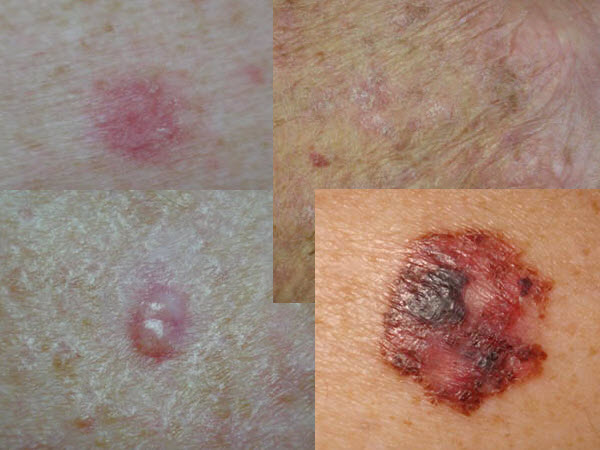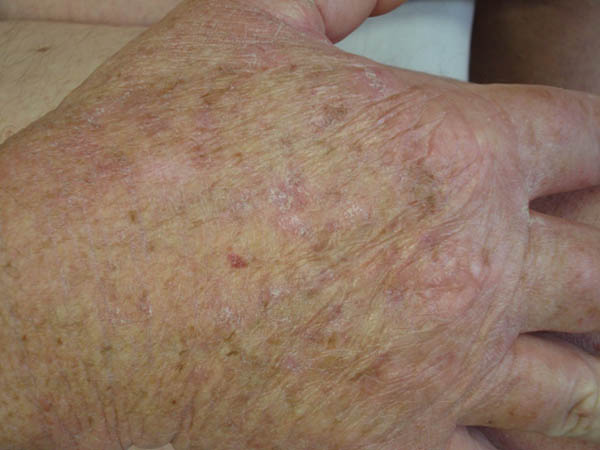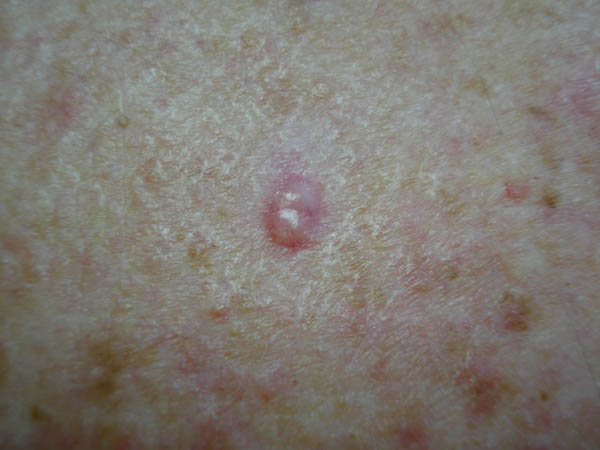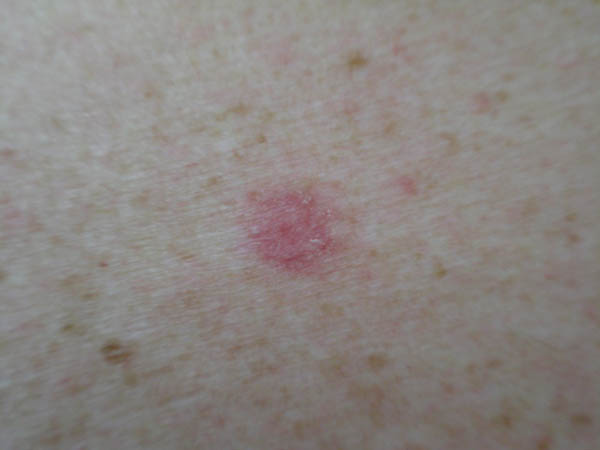Paddlers beware: Silent Killer on the loose
[Editor: In the Southern Hemisphere, we're approaching summer... and here's a timely article from dermatologist Dr. Gavin Gottschalk to remind us that that it's not all fun in the sun...]

Surfski lovers in Cape Town are enduring another torrid spell of storms, rain, hail and fierce North-Westerly gales.
There has been the odd sunny day, but unless you're a member of the Rob Mousley "reverse-Miller in squall conditions" brigade, our surf skis remain unhappily strung across their wall-mounted brackets. This dire situation inevitably leads to day-dreaming of paddling in the much awaited spring and summer sunshine. Yeah baby, bring on that bright yellow orb, it's time to turn my pecs golden brown.....
Not all fun in the sun
Of course, surf skiing isn't all fun in the sun. The pages on this website have all too eloquently documented some of the hazards of our sport:
-
Shark incidents (several stories),
-
blue bottle sting anaphylactic reactions (this author having endured a particularly nasty episode, see http://www.surfski.info/content/view/381/155/) ,
-
striking hidden objects far out to sea and watching your boat sink (See Oscar's long swim http://www.surfski.info/content/view/363/154/),
-
hypothermia (see http://www.surfski.info/content/view/330/154/),
-
getting lost in the fog,
-
being struck by speedboats (http://www.surfski.info/content/view/551/147/),
blisters, chafe, dehydration...... A non-paddler would surely balk.
The thing, though, about all these potential hazards is that they are pretty immediate problems. They happen, they're over, deal with it and/or suffer the fall-out. The shark bites and "crunch". The blue bottle stings and "ouch". Etc. Most paddlers, certainly in Cape Town, are very safety conscious and stick to the basic rules: PFD, cell phone, leash if windy, juice if hot and a long paddle, tell someone close to you where you're paddling and what time you're expected off the water and then tell them when you're off the water, and so on. (Although it still amazes me when I see guys off Barker Rock on a big day without a PFD - it's 2km off-shore and has taken lives and boats before).
Silent Killer
But what about the silent killer? What about the problem that isn't so immediate, that slowly attacks every time we're on the water, yet only strikes the killer blow years later? Ok, so the sharp amongst you have figured out my corny weather intro. And for the others, I'm writing about the SUN.
I'm a dermatologist, and several months ago I promised Rob that I'd write an article for the website to try and highlight some of the dangers of chronic sun damage. I've been paddling for 3 years now and have been amazed at how many of the paddling community are so sun unaware, or simply "I don't care". Perhaps it's part of the tough guy, beach jock attitude that sometimes prevails.
More importantly, though, I think it's because of the lack of immediacy of the problem. The shark bites and "crunch", but the damage that the sun does to your DNA will only manifest as cancer many years later. So why bother now? The redness of my sunburn will be gone in 3-4 days, and then it's only a bit of peeling and I'm fine. And my girlfriend loves the tan..... (It equally amazes me when I see the guys off Barker Rock without a PFD or a shirt, when I think of how they're frying themselves).
And so with spring approaching I thought that I'd better pull finger and produce the article before the sun offers up a few more cases of cancer needing excision.
I've had the privilege of looking after a good number of the local paddling community. But I've been saddened because, at a thumb-suck, around 50% of them have had skin cancer in one form or another. And these are not patients in their 70's, who have accumulated a life-time of sun-damage. These are patients in their 20's-40's. Many of them have a lifeguard background and so have been on beaches since childhood. But here is the critical fact: sun reflectance off water magnifies the exposure dramatically, 2nd only to snow. So even short periods, accumulated over many years, actually amounts to significant damage.
Read on (please)
So please allow me a bit more of your time, and read on. I'd like to offer a few bits of practical advice on how to be more sun conscious. I know that it's not usually the coolest thing in the world to look like a cricket outfielder with a wide hat and a face plastered white, but believe me, it's even less cool when you have to have a chunk of your face cut away because something is growing there.
Note: this is in no way intended to be an academic article. For more further information on skin cancer, one can follow these links:
-
The Australasian College of Dermatologists at http://www.dermcoll.asn.au/public/a-z_of_skin.asp#Sun_Protection;
-
British Association of Dermatologists at http://www.bad.org.uk/public/cancer/;
-
The American Academy of Dermatology at http://www.aad.org/forms/SunSafetyDatabase/default.aspx
Check List
Below is merely an informal check list which I hope will prove handy. Bear in mind also that fair-skinned people are far more at risk of sun damage than dark-skinned people. The latter can get some premature photo-aging and rarely skin cancer, but they are at far lower risk. The darker the skin, the lower the risk.
So what kind of damage does the sun do? This can be divided into 2 main groups
Chronic Actinic Damage
The first group is called "chronic actinic (sun) damage". Assuming you don't visit nudist beaches regularly, then take a look at the skin on your buttocks, or your breasts if you're a woman. The upper inner arm is another good spot. These are sun-protected areas and the rest of you skin would look similar to this if you weren't a paddler in a sunny climate. It's probably smooth, soft, unblemished and certainly a lot paler compared to elsewhere. Now take a look at the skin of the back of your hands, or perhaps your face, and you'll see that it's probably thicker, wrinkly, more leathery, darker, with broken veins and possibly blotchy to some degree. Or some combination of those features. That is premature "photo-induced aging", or "chronic actinic damage".
The second group is skin cancer and it's useful to know that there are a few different kinds. I'll describe the commonest:
Skin Cancer
Actinic keratosis, or solar keratosis: This is the most common. It occurs on sun-exposed areas, as a scaly, rough, sometimes red or pigmented spot or patch. Sometimes dermatologists refer to this as a "pre-cancer" i.e. it might go on to become a "full-blown" cancer at some point (see squamous cell carcinoma below).

Basal cell carcinoma, sometimes called a "rodent ulcer": This is the most common kind of "full blown" cancer. Occurs on sun-exposed areas. Usually a small lump (sometimes ulcerated) or a red patch. Doesn't spread to other parts of the body (metastasize) but will grow bigger and slowly ‘eat into' surrounding structures e.g. nose, eye, ear.


Squamous cell carcinoma: Usually on sun-exposed areas. A flesh-coloured growth which may ulcerate or look warty. Has the potential to metastasize and kill, but this doesn't happen often. Can grow very big and ‘eat in'. (No photo available, sorry. Check out the Australian website for an example.)
Melanoma: The most dangerous as it metastasizes easily and is a killer if not caught in time. Usually appears as a darkly pigmented mole which is growing ‘abnormally.' Usually on sun-exposed skin, but can be on skin of any part of the body e.g. between the toes, on the buttocks.

For practical purposes, if you have any spot/growth/patch on your body that:
-
Is not healing (very important)
-
Wasn't there before
-
Is growing bigger
then please consult either a dermatologist or a GP who has experience with skin cancer.
Remember your ABCDE
With regards to moles growing ‘abnormally', it may be useful to remember ABCDE:
-
Asymmetry: i.e. a symmetrical (if you theoretically divided it in half you'd be able to fold it evenly on itself) mole is good, the opposite is bad.
-
Border: i.e. a smooth border is good, ragged border is bad.
-
Colour: i.e. an even colour is good; different colours/shades in the same mole are bad
-
Diameter: i.e. growing bigger is bad
-
Elevation: a mole that was flat and then lifts up needs checking out; E also stands for Evolution, which encompasses all of the above i.e. if a mole is changing in any way, have it checked out.
When in doubt - consult your doctor
The photos I have attached are merely examples. They do not in any way cover the full-spectrum of how skin cancers can look. You can find other examples of these on the websites listed. Wherever you are in the world then pleeeeease see you doctor if you have any doubts whatsoever.
Prevention is better than cure
Here are some tips on sun protection whilst on the water:
Sun block.
Use at least a 30-50 SPF to all exposed areas. Make sure that the brand you're using states protection against UVA and UVB.
Apply about 30 minutes prior to getting on the water so that it's properly absorbed.
Wash the palms of your hands vigorously with water afterwards otherwise your paddle shaft will go slip sliding away! Use a brand/formulation on your face that won't run into your eyes while you're sweating 10km into a race on a hot day. Burning eyes = I can't see = I fall out. I find that the formulations that look like giant lip sticks are good for this as they are quite greasy so they don't run, and one can apply them by ‘painting them on' which circumvents the slippery hand problem.
When you come off the water after 1-2 hours of hard racing, then a combination of sweating and splashing means that your sun block has disappeared off your skin. So while you spend the next couple of hours at prize-giving drinking beer and chatting, re-apply your cream! Spots that are typically neglected: ears (especially the top), lips, back of hands.
Hat:
A peak cap is better than nothing, but it's really only doing (less than) half a job. It leaves the back of the neck and the ears totally exposed. And when you're facing any direction other than directly into (or away from!) the sun, then it leaves your face exposed, too. Try and forego the "looking cool" factor and find either a broad-rimmed hat or a peak that has flaps on side and back. Try also to find a hat that has a chin strap so that it doesn't blow off- these are becoming more readily available as water sports lovers become more sun conscious. I think I'm one of only two paddlers on the local scene who wears a broad-rimmed hat, but I don't stress about not looking cool as I'm near the back of the field anyhow so very few people get to see me! It's such a stand-out, actually, that one fellow racer once told me that he uses my hat as marker during a race. Here's hoping I'm less conspicuous this coming season.
Clothing:
All clothing by its very nature has an SPF factor i.e. it physically blocks the sun. This is probably better than a sun block anyway (avoids chemicals, doesn't wash off). There are water sport-specific materials available that are designed with SPF's of around 50 or higher, that surfers and paddlers can wear with comfort. They're often cooler (temperature cooler, not necessarily "looking cooler"...) than the thermal-type tops. Wear them. If it's a very hot day then go with the short sleeve and apply cream to exposed areas. Even better, if you can tolerate it, then go with the long sleeve version. Try and avoid wearing only a vest, or shame on you, going bare-chested.
Sunglasses:
Personally I struggle with these as I hate it when they get wet and I find the decreased light reaching my eyes impairs my "feel" of the water. But, there is no doubt that they will protect your eyes from excess UV light and if you can tolerate them, then wear them.
Paddling times:
Try and avoid training in the peak hours of the day. Certainly in Cape Town in summer, the sun is extremely harsh between 11h00 and 16h00. I often paddle at 06h00 at that time of the year, and even then I gradually pick up a tan. Contrast this with 15 min of unprotected sun exposure at 13h00 and I'm burned red! And here's an appeal to race organizers: please try and start races as early as possible to avoid putting competitors out there in the heat of the day. I realise that other factors are also involved, such as waiting for good winds for a downwind race, but it's worth bearing in mind. Sun protection should be part of any safety talk at surf ski schools and paddling stores (Dawid and Nikki take note!)
Checkups:
If you have any doubt about a strange mark or growth on your body, then please don't hesitate and go see your doctor. I have seen too many cases of patients who delayed for a variety of reasons (too busy, too scared, don't care, it'll never happen to me, it's nothing). Be skin aware and check yourself our regularly to look for changes. Better still, get a significant other to check you out, especially in those hard to see places (yes, all those hard to see places...)
"PFDs, Leashes and Sunscreen Compulsory!"
Imagine this scenario: Race organiser Billy Harker blaring through the loudspeaker 15 min before a race this December. "The wind is 30km/hour and leashes/PFDs are compulsory. Any paddler racing without these two items of equipment will be disqualified. And finally, the sunburn factor today is HIGH. The Powerade girls will be doing a finger swipe test down the arm and cheek of all competitors to check whether they've applied cream! Those who have not complied will not be allowed to race!"
OK, so maybe that's pushing it a bit. But whilst hypothermia, shark attacks and other horror stories are dramatic and make us all sit up and take notice, they are relatively extremely rare. Skin cancer from the sun, however, is relatively extremely common. Paddlers are at HIGH risk......
Paddle safe!

